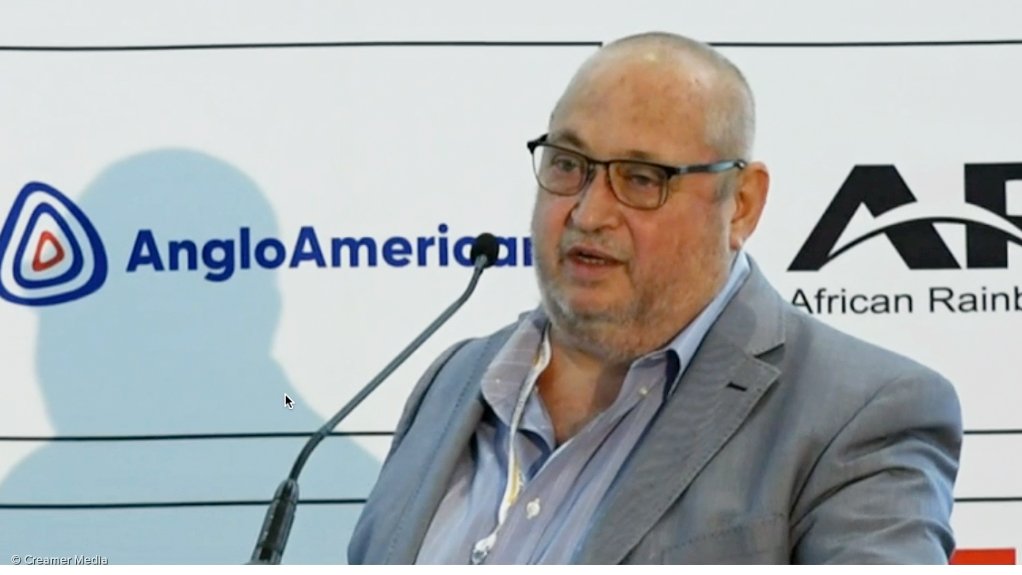Market development of full PGMs basket is essential, Industry Day hears




PGMs Industry Day covered by Mining Weekly's Martin Creamer. Video: Darlene Creamer.
Neal Froneman
Photo by Creamer Media
Johnson Matthey PGM advocacy manager Margery Ryan
Photo by Creamer Media
Forecasts need to prompt immediate action.
Photo by Creamer Media
JOHANNESBURG (miningweekly.com) – Representatives of the producers of 90% of the world’s climate-vital platinum group metals (PGMs) heard during Wednesday’s PGMs Industry Day that market development of the full PGMs basket – and not just platinum and palladium – is essential at this time of global implementation of a cleaner and greener decarbonised planet.
In advocating this, PGMs producer Sibanye-Stillwater CEO Neal Froneman also highlighted the role of PGMs as unique metals that provide a far-reaching prop up for the strongly advancing hydrogen economy. (Also watch attached Creamer Media video.)
“Very important is that we start focusing on industrial underpins to reduce the dependence or the exposure to risk on autos," Froneman told the Resources4Africa event covered by Mining Weekly.
“I'm reminded of a rule I was taught many years ago, and it's called Noah’s Rule – don’t try and predict the weather, just go out there and build the ark so that it’s ready when the rain comes down,” said Froneman in suggesting that the PGMs industry collectively develop the market and reap the benefit of the resulting demand.
“The underpin for demand for the right PGMs is still solid… and a lot of PGMs have substantial non-automotive underpinning, and one of my conclusions is that we’ve got to become less dependent as an industry on autos,” he told the event, chaired by mining luminary Bernard Swanepoel.
While overall palladium demand is decreasing, the future roles of some minor PGMs are increasing markedly.
Moreover, there is no doubt about hydrogen becoming an increasingly important driver of demand for some PGMs, along with the regulation-linked PGM loadings increases, as well as the positive 42% compound annual growth rate for fuel cell electric vehicles.
“Demand has been stable, which is very important to note, but it's not appropriate for end-users or asset suppliers to develop a supply response that is out of kilter with the demand response in terms of the make-up of these metals.
“The proportions of the various PGMs must be examined across the entire global PGMs supply base and we've got to create demand that fits that, otherwise we're going to either create demand destruction, or we're going to create huge volatility.
“Instead of driving platinum demand alone, we’ve got to drive market development across all PGMs to create a demand base that represents what we mine,” Froneman emphasised.
A strategic approach to market development is seen as the correct approach. As such, PGMs must be acknowledged as industrial metals, while demand is aligned with what is produced as well as market development spread across the basket.
“We’ve got to invest in sticky industrial demand. We need to focus on global decarbonisation as an area where the unique properties of PGMs can play a role. You can't look at platinum and palladium in isolation anymore."
Meanwhile, the supply is decreasing, there has been a lack of capital investment and, in the short term, a supply downside is expected as loss-making mine shafts are closed.
"In our view, they are substantial deficits in this business out to 2030. To me, that makes for a good PGMs business.
"I don't buy into the current negativity and don't buy into a two-year recovery timeframe; recognition by the market that sentiment is changing is already being seen and share prices are going up," Froneman said.
A destocking phase was caused by disruptions in the supply chain is being recognised and two element PGMs demand out to 2030 is viewed as being solid and stable.
“It’s clear that hydrogen is going to be produced and we should make sure that PGMs underpin clean hydrogen in the lowest-cost way.
“We need to do market development on the full basket and not just platinum and palladium and ensure that it's PGMs that underpin clean hydrogen in the lowest cost-plus way,” he added.
PGM EXPLORATION
Minerals Council South Africa CEO Mzila Mthenjane highlighted the need for PGMs exploration to be set in motion to ensure stable ongoing PGMs supply into the future to avoid supply chain strain.
“When I look at the PGMs industry through the lens of critical minerals, the big topic of the global north is one of risk of supply chains.
“That, in my view, presents an opportunity for countries like South Africa,” said Mthenjane.
He described the biggest task of his job as engaging with policy makers to spread understanding of the market needs of the PGMs industry and the benefits of employment, investment and economic development that would emerge from such understanding.
He emphasised that the dominant PGMs position of Southern Africa called for supply discipline to ensure the avoidance of supply disruption.
The 5% and 6% respective PGM production declines in the years 2022 and 2023 pointed to respositioning and preparation being necessary for the upcoming demand opportunities.
In its engagement with the Department of Mineral Resources and Energy (DMRE), the Minerals Council was thus focusing on the stabilising by major producers of current production as well as on the absolute necessity of including exploration for more PGMs.
“We’re engaging with the DMRE on how we improve exploration expenditure for South Africa, which has declined from 10% of global share ten years ago to less than 1% currently, and this goes across different commodities.
“If we are to harness the opportunity that is presenting itself in the PGMs sector, I think we’re going to need to put a lot of effort into exploration.
“Irrespective of which political party is in government in future in South Africa, a very robust economic plan will need to be in place, underwritten by a well-thought-through mining investment strategy.
“I believe that of all the sectors, perhaps right now, mining represents a low-hanging fruit. A look at the outstanding exploration permits shows that about R30-billion worth of investment is being held back," Mthenjane noted.
From an exploration perspective, the positive impact of that investment could conceivably help to uplift the economy in as few as six to 12 months.
“So, I think it's important that we give huge focus to the PGMs industry, which 2023 numbers show is the largest employer that spends the most on community development and contributes 10% of total exports to South Africa," Mthenjane pointed out.
RUTHENIUM AND IRIDIUM
Johnson Matthey PGMs advocacy manager Margery Ryan spoke of the major opportunity the clean energy future was presenting for PGMs and emphasised that PGMs were equally crucial to ensure the realisation of the world’s climate-critical energy transition.
Ryan highlighted the sustained growth demand for ruthenium and iridium PGMs.
“Setting aside whether that can be met, that requirement is there and much of that is being driven by the use of those two metals in technologies for the energy transition,” Ryan said, while also pointing to a fair outcome for platinum.
An infogram displayed showed a decline in the older automotive market for platinum catalytic convertors and growth in the replacement automotive market for platinum fuel cells.
“We’re looking at quite a decline for palladium and rhodium. Let me emphasise this is a projection based on what we know,” said Ryan, who highlighted the company’s forecasting philosophy by displaying this telling quote of Stanford University professor Paul Saffo: “The goal of forecasting is not to predict the future, but to tell you what you need to know to take meaningful action in the present.”
Article Enquiry
Email Article
Save Article
Feedback
To advertise email advertising@creamermedia.co.za or click here
Announcements
What's On
Subscribe to improve your user experience...
Option 1 (equivalent of R125 a month):
Receive a weekly copy of Creamer Media's Engineering News & Mining Weekly magazine
(print copy for those in South Africa and e-magazine for those outside of South Africa)
Receive daily email newsletters
Access to full search results
Access archive of magazine back copies
Access to Projects in Progress
Access to ONE Research Report of your choice in PDF format
Option 2 (equivalent of R375 a month):
All benefits from Option 1
PLUS
Access to Creamer Media's Research Channel Africa for ALL Research Reports, in PDF format, on various industrial and mining sectors
including Electricity; Water; Energy Transition; Hydrogen; Roads, Rail and Ports; Coal; Gold; Platinum; Battery Metals; etc.
Already a subscriber?
Forgotten your password?
Receive weekly copy of Creamer Media's Engineering News & Mining Weekly magazine (print copy for those in South Africa and e-magazine for those outside of South Africa)
➕
Recieve daily email newsletters
➕
Access to full search results
➕
Access archive of magazine back copies
➕
Access to Projects in Progress
➕
Access to ONE Research Report of your choice in PDF format
RESEARCH CHANNEL AFRICA
R4500 (equivalent of R375 a month)
SUBSCRIBEAll benefits from Option 1
➕
Access to Creamer Media's Research Channel Africa for ALL Research Reports on various industrial and mining sectors, in PDF format, including on:
Electricity
➕
Water
➕
Energy Transition
➕
Hydrogen
➕
Roads, Rail and Ports
➕
Coal
➕
Gold
➕
Platinum
➕
Battery Metals
➕
etc.
Receive all benefits from Option 1 or Option 2 delivered to numerous people at your company
➕
Multiple User names and Passwords for simultaneous log-ins
➕
Intranet integration access to all in your organisation


















